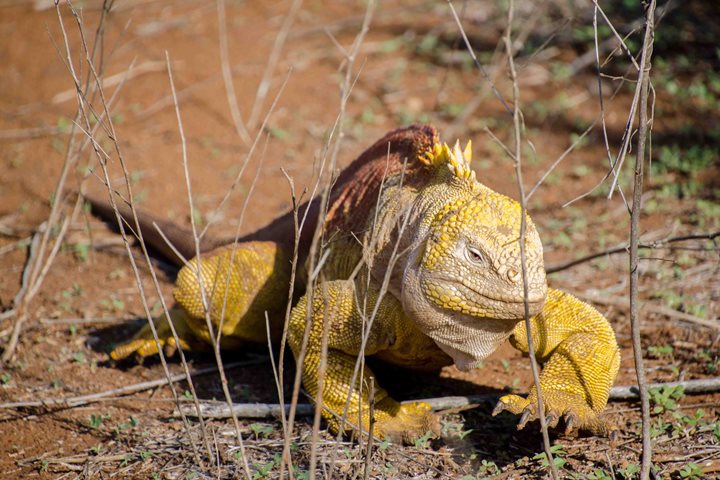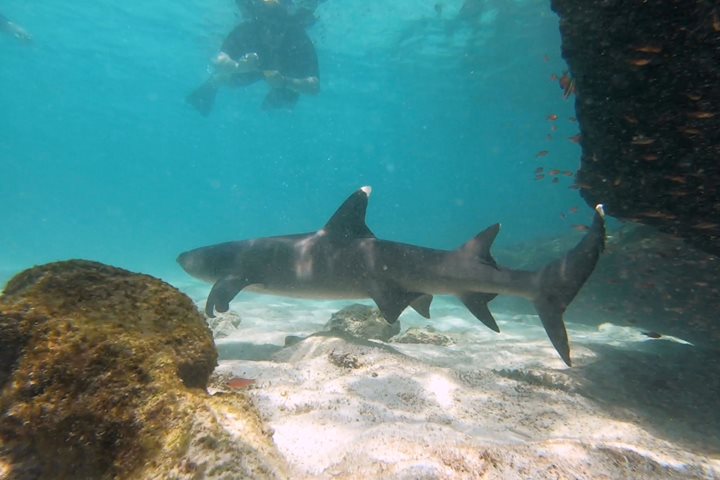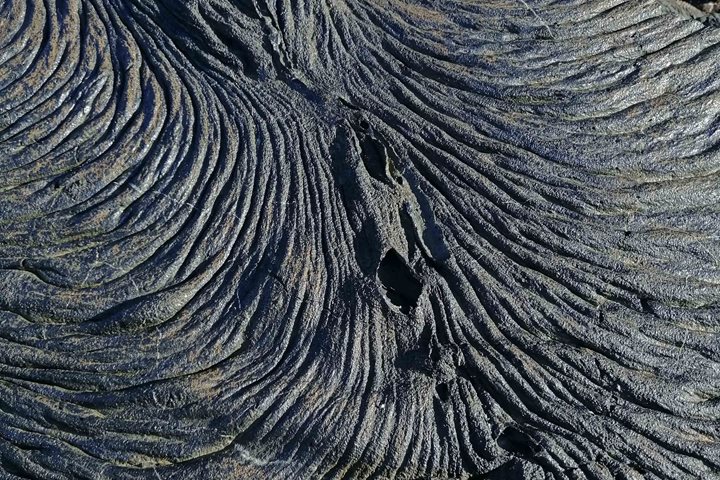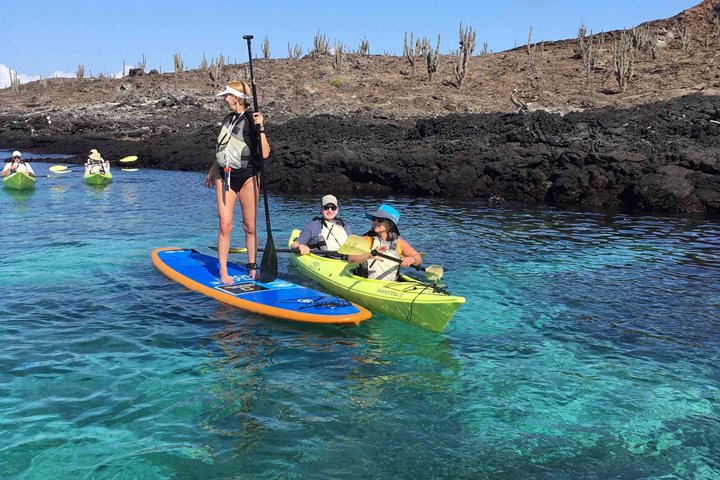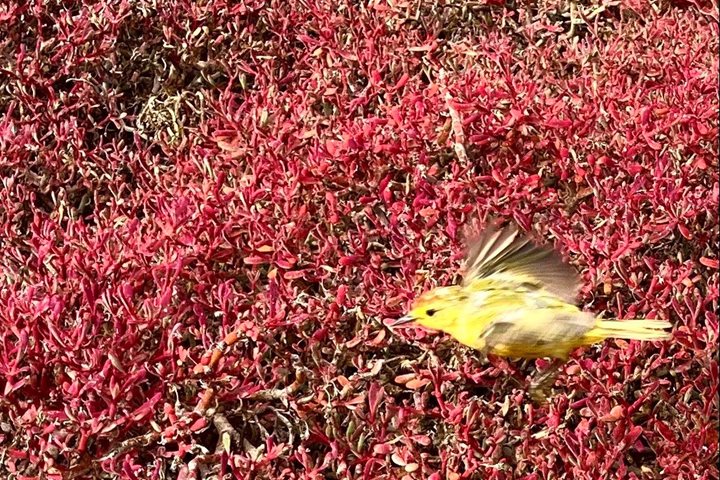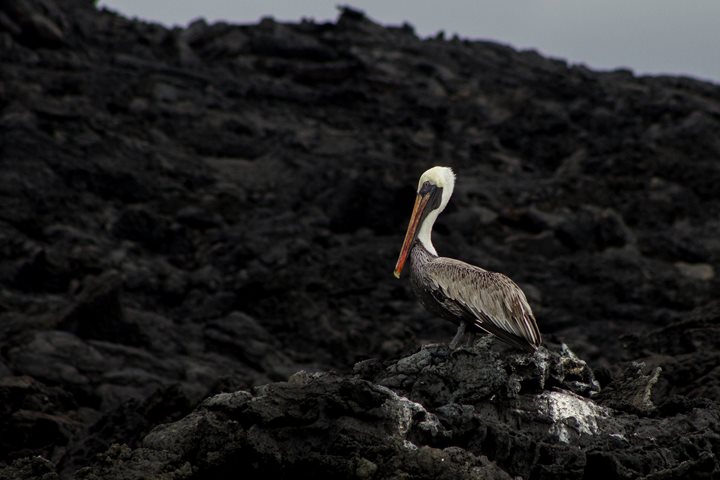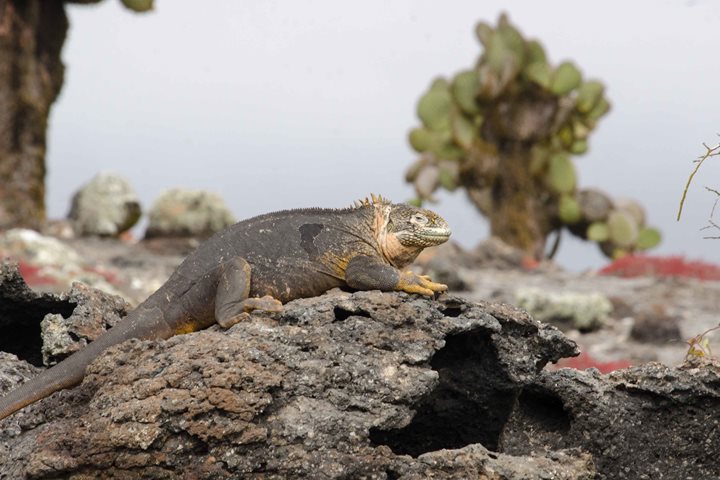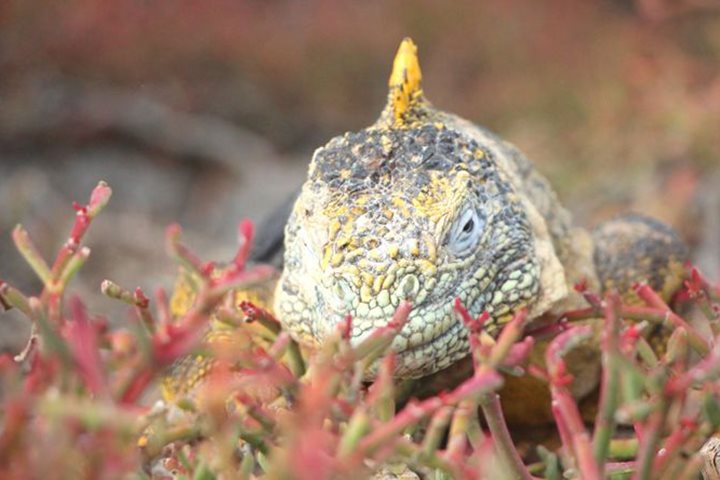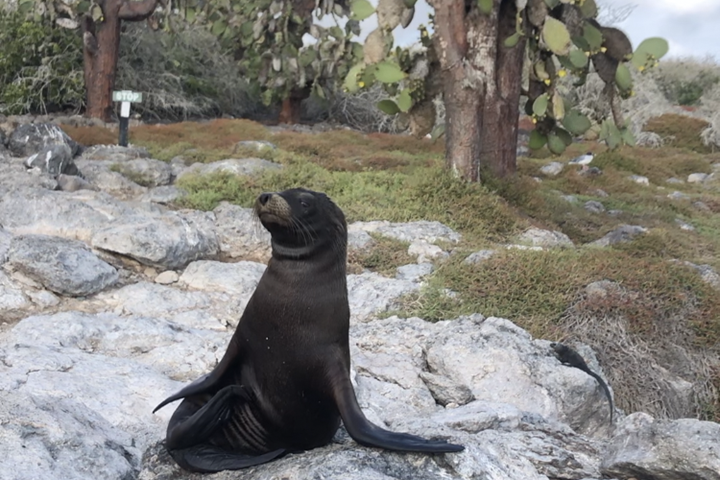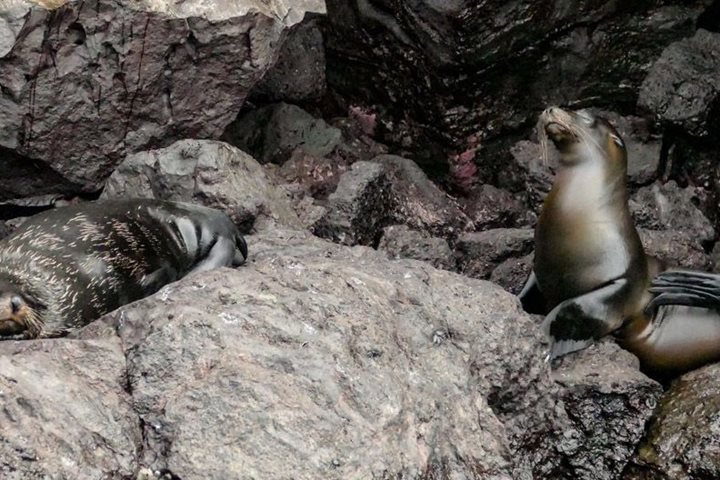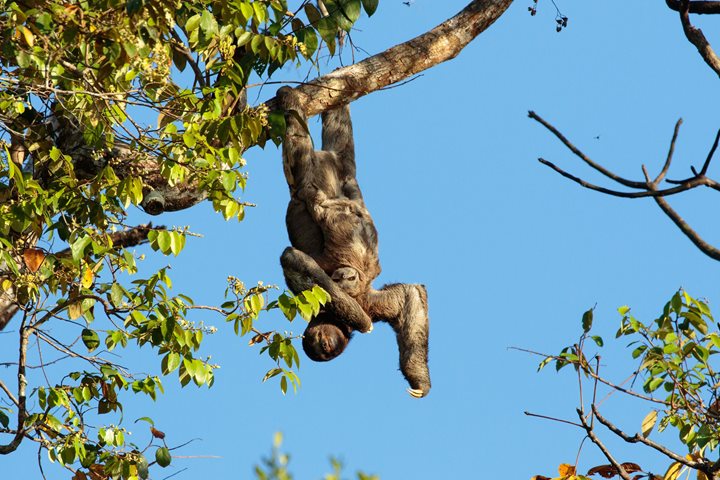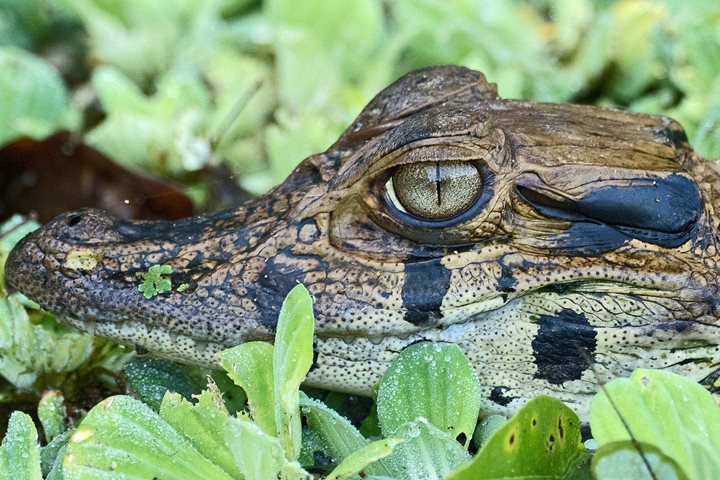Call +1.800.397.3348 or contact your travel advisor
Expedition Stories
Our fleet navigates the world in search of adventure. These are the stories they bring back…
Loading...
Loading...
Previous Reports
2/1/2017
Read
National Geographic Endeavour II
Santa Cruz Island
Our plan for the day was to explore the northern shores of the island, hoping to encounter wild Galapagos land iguanas. In the afternoon, we planned to explore the underwater world at the Guy Fawkes Islet and then finish our day sailing around the famous Daphne Major. After an early breakfast we set off to our disembarkation point at Cerro Dragon. After a walk of about a hundred yards along the shoreline, we went inland to explore a deciduous Palo Santo forest. It seemed that the very first rain of the season had fallen a mere few days ago, as the trees were starting to produce new green shoots. The new sprouting vegetation is an important food source for the local land iguanas, so we were lucky to see many Land Iguanas grazing just after coming out of their burrows. Large males seem to be getting more colorful than usual, as the mating season is about to start. After enjoying the incredible photo opportunities of the morning’s excursion, we headed back to the shore to take our zodiacs back to the ship. Once on board, we got ready to explore the underwater world, either by swimming and snorkeling from a beach or by snorkeling at the nearby Guy Fawkes Islet, which proved to be one of the best snorkeling outings we had so far during this expedition. Several of our guests had the opportunity to interact with the local sea lion pups, as myriads small fish swarmed in the shallows, while some other guests had the chance to see white-tipped reef sharks and a larger Galapagos shark. Once back on board, we enjoyed a typical Ecuadorian lunch as our ship heaved anchor to take us out to sea. As we closed down on Daphne Major, naturalist Fabio Buchelli gave a talk on Charles Darwin and his visit to the Galapagos Archipelago. As sunset drew close we gathered at the sundeck for a wine tasting while expedition leader Paula Tagle told us about the unique circumstances and results of Peter and Rosemary Grant’s research on this tiny speck of land. As I write these last lines, guests gather at the lounge to learn about what new and exciting experiences a new day will bring us. Last night, the National Geographic Endeavour II heaved anchor just past midnight to sail around the east coast of Santa Cruz Island to its northern shores. This morning as first light broke our ship rode anchor gently in the protected waters of the northern coast.
9/13/2019
Read
National Geographic Islander
Sombrero Chino and Sullivan Bay
Friday the 13 th found us on a real adventure! King Neptune sent the WINDS this morning! When we dropped anchor shortly before 6:00 at the mouth of a picturesque channel between an extensive barren lava flow and the islet that does indeed look like a Chinese hat, the wind was blowing, but the Captain and I deemed it safe for kayakers and paddleboarding. By the time the early riser paddlers returned to the ship, exhilarated and wet, the winds had picked up significantly! I cancelled the second round of kayaking, but three Zodiacs went out to explore the shores of this lava field that dates back to 1897. Snorkeling was next on our schedule, and despite the winds, it was a huge success! The water was a cool 68 degrees Fahrenheit, but heck – we are searching for penguins! Yes, because these islands are bathed in cold currents from the south – the Humboldt – and the west – the Cromwell – penguins arrived, adapted, and thrive in the Galapagos. The endemic Galapagos penguin are among the smallest in the world. The snorkelers swam along the edge of the Santiago lava flow and were rewarded with very good sightings of sharks, rays and colorful schooling fish of many species. We felt like we were swimming in a fish tank; the water was so clear! But the winds continued and made our exit from the water a bit of a challenge. After we enjoyed an abundant and delicious traditional Ecuadorian buffet lunch, and a well-deserved siesta, Naturalist Ben gave an interesting talk about Charles Darwin and his trip through these islands over 180 years ago. We boarded the Zodiacs and went again to search for penguins and were delighted to find six of them! Our afternoon hike began with a dry disembarkation right on the lava flow. We hiked for a mile on the ropy “pahoehoe” lava, were delighted and amazed at the varied textures, colors and forms in this lava field, and we took many photos!
11/8/2019
Read
National Geographic Islander
Santiago Island
Today we woke up in front of Sombrero Chino Islet. A pre-breakfast kayaking session was offered for our first activity of the day. For those choosing to sleep in a bit, a second round was provided after breakfast, as well as an optional Zodiac ride to discover the wonders of this protected channel. We saw Galapagos penguins and playful Galapagos sea lions in and out of the water. Snorkeling in Sombrero Chino was like swimming in an enormous aquarium with incredible clear water and abundance of colorful fish! Our afternoon was spent in Sullivan Bay where we hiked on young lava fields. With the amazing landscape, it’s easy to imagine how life started in our beautiful planet.
2/14/2020
Watch
National Geographic Islander
Chinese Hat and Sullivan Bay, Santiago Island
Today we woke up at Chinese Hat in Santiago Island. Some guests went for a pre-breakfast stretch class in the nearby beautiful sandy beach. After a delicious breakfast, we disembarked for a Zodiac ride, followed by a snorkeling session along the shore of Santiago Island. The great visibility today allowed us to see plenty of wildlife, including Galapagos penguins, sea lions, whitetip reef sharks, and many other species of fish. In the afternoon while some guests went for a walk on Sullivan Bay’s lava flow, others took a second snorkeling opportunity in the hopes of seeing a group of penguins wandering along the coast. We ended the day on the sky deck of National Geographic Islander appreciating the sunset while wine tasting.
6/2/2022
Read
National Geographic Islander
South Plaza and Santa Fe Islands
This morning, National Geographic Islander guests visited South Plaza Island. The coloration of Sesuvium sp is perfect against the deep blue of the ocean. The rocky trail–home to swallowed-tailed gulls, lava lizards, and marine iguanas–led us to the rocky shore. We found a big colony of Galapagos sea lions playing along the coast. In the afternoon, Santa Fe Island offered us the chance to observe unique species like the Santa Fe land iguana, which is quite different from the Galapagos land iguana. Santa Fe land iguanas are not only bigger in size, but much more of a pale yellow in coloration. A boulder trail, surrounded by a dense forest of treelike cactus called Opuntia, ended at a white sand beach crowded with a colony of sea lions resting at sunset.
6/3/2022
Read
National Geographic Islander
Chinese Hat & Sullivan Bay
A clear sky received National Geographic Islander in the middle of the islets around Chinese Hat and Santiago Island. The first activity was kayaking along the channel in between Chinese Hat and Santiago Island. We explored the area with Zodiacs and kayaks. We were looking for wildlife, as this site is home for small colonies of Galapagos penguins and sea lions. In the afternoon, we went hiking on a very young lava flow, just over 100 years old. This lava flow covers a big portion of Santiago Island, and it is a good place for understanding how life started in the Galapagos. We walked around a great area of the flow, finding endemic lava cactus and insect species.
9/12/2019
Read
National Geographic Islander
South Plaza and Santa Fe Island
Today we visited the small islet of South Plaza for an excellent opportunity to spot Galapagos land iguanas, and after lunch, sailed south to Santa Fe Island for some kayaking and hiking. We hesitated to leave the inquisitive sea lion pups we encountered after our wet landing to move further inland. This decision proved fruitful though, as we saw many rare Santa Fe land iguanas basking on rocks along our trail, and even the very elusive “hamster-like” Santa Fe rice rat.
11/7/2019
Read
National Geographic Islander
South Plaza & Santa Fe Island
After a filling breakfast we went in search of wildlife, and shortly after our dry landing encountered playful sea lions and land iguanas. The latter were in great numbers. Their rapid growth population is mainly due to the lack of any major predation from animals such as hawks, and competition for food. A large population of cactus trees keep the land iguanas healthy and shaded. One of the most picturesque landscapes are found here; the ground is covered in portulaca with striking color, and the low elevation allows us to see almost every angle of it. Seagulls were plentiful, and many were seen nesting or feeding and protecting their chicks. To make the morning even more interesting some guests had a jump into the ocean from the ship. In the afternoon, we navigated to neighboring Santa Fe for more exiting activities. Kayaks and paddleboards were lowered into the beautiful bay, giving guests an up-close view of the landscape and wildlife Santa Fe has to offer. Later, we landed on a white sand beach and encountered many sea lions - individuals or in groups, all doing something fascinating! We walked along a trail and found more wildlife, like the endemic Santa Fe land iguana, lava lizards, and many land birds. Even the bay’s shallow water harbored plenty of life like eagle rays, turtles, white-tip reef sharks and more. Our day ended with a colored sky as the sun settled into the horizon.
2/13/2020
Read
National Geographic Islander
Plazas Island and Santa Fe
Our exploration of the Galapagos islands has led us to Plazas Islet today. We had the opportunity to see our first conolophis cristatus land Iguanasm, and they were all over the place eating opuntia cactus! Others were seen fighting for a bite. Later in the afternoon we visited Santa Fe Island for some kayaking in the beautiful bay surrounded by marine turtles and rays. We then hiked along a trail and spotted our second species of land iguana, the conolophus palidus . Back on board the activities continued with recaps, and naturalist shared new information about the Galapagos Islands. There is a lot to learn aboard National Geographic Islander !
2/15/2020
Read
National Geographic Islander
Genovesa Island
When we woke up, already anchored in the bay of Genovesa Island, the sky looked overcast, a little dull to tell the truth. But as the minutes went by, it became clearer and clearer, sunnier and sunnier. The early birds went out on the last kayak and paddleboard outing, our fourth of the trip! In calm waters, at the inside base of a crater wall, great frigate birds and red-footed boobies perched on branches overhanging the sea. The courtship season of frigates has begun, and the warbling “woo-woo” sounds reverberate around the bay. A new-born – and I mean NEW-born sea lion pup fascinated everyone. How often does one ever get to witness, and at such close range, the birth of a wild animal? When the morning got too hot, it was time to get wet. Some folks chose to stay at the beach to swim and snorkel, while others chose to go deep-water snorkeling along the crater walls across the bay. Genovesa is located in the very northeast corner of the archipelago. As such, the warmer waters of the Panama current influence Genovesa more than the other islands we have visited so far; I measured the temperature at 81 degrees Fahrenheit! No wetsuit needed today, even if you do live in Florida! The afternoon was dedicated to exploring a landing site known as “Prince Philip’s Steps”. To get there, one has to ride in Zodiacs a mile across the bay. On arrival, the 80-foot bluff rises up vertically. But no! A crevice opens up; a fissure angles in. At the base of the cliff, a small colony of Galapagos fur seals reside. We were fortunate enough to find a young Galapagos sea lion – about 2 years old, on a rock right next to an adult Galapagos fur seal. Perfect conditions for a bit of comparison between two completely different genera of marine mammals. Prince Philip was a long-time honorary member of the Charles Darwin Foundation, and explored the islands when they were first recognized and protected by Ecuadorian law. With a bit of concrete and a few wooden handrails, you can reach the top to find an ethereal world of noisy Nazca boobies, calling frigates and honking red-footed boobies. Its level trail is placed over uneven slabs of old pa-hoe-hoe lava, tilted drunkenly and cracked, opening holes here and there. Nazca boobies dominate the scene, while red-foots play a supporting role in the trees. Galapagos storm petrels flit over the lava crust, hoping to avoid the attention of hiding short-eared owls. One owl caught a storm-petrel, other owls waited in the distance. The trail finally takes you to a view looking out at the East Pacific Ocean – looking south. If we could, the central islands of the Galapagos Archipelago might be seen from here – but no – as its 50 nautical miles away with hazy conditions most of the time…it seems there is nothing more out there. You are alone, on an island of birds.
6/2/2022
Read
Delfin II
Belluda Creek and El Dorado River
We woke up to the sound of the wilderness in the vast Upper Amazon in Peru. Miles of trees embraced by flowing water and birds of all kinds flying overhead was the first scenery we had from the upper deck aboard Delfin ll . We decided to start our expedition day with a pre-breakfast skiff exploration in search of birds. Not long after we left our mother ship behind, we encountered blue-and-yellow macaws flying overhead and a couple of wood storks feeding on small freshwater sardines as they looked for small crustaceans on the side of the river. We also spotted several species of kingfishers and a couple of roadside hawks. We were lucky to spot one bat hawk perched in the top of a Cecropia tree. After our birdwatching skiff ride, we came back aboard Delfin ll for an orientation lecture to introduce us to the Amazon region. Here in the Amazon, the flavors are rich. The bodies of water provide food for the animals inhabiting the ecosystem and also for locals and transitory humans. We had the opportunity to taste several local exotic fruits, most we had never seen before. One of our local naturalists explained each fruit we tasted so we could learn about it. After lunch, we had a lecture about nature photography. Our photo instructor showed us techniques to capture the wildlife and scenery here in the Amazon. While learning about photography, we saw a few pink dolphins swimming around the ship. We got ready to go kayaking with the hope that some of these dolphins would come near us. A couple of pink dolphins were curious about us in the kayaks, and they gave us the opportunity to take a good look at them. After kayaking, we explored the Dorado River with the hope of observing new species. We were extremely lucky to find a couple of red howler monkeys. As soon as night arrived, we spotted several reticulated and black caimans. Using a spotlight from the skiff, we spotted the caimans’ eyes from a distance. Once night fell around the Amazon, all the sudden we had plenty of shiny little eyes around us. Those eyes belonged to baby caimans sheltering under shrubs and looking at us from the muddy riverbank. We stayed in the area admiring these elegant reptiles. On our way back, we saw some owls and night herons flying in the distance. We also spotted a few fishing bats feeding off the surface of the water. It was a very unique experience to spend time at night in the middle of the Peruvian Amazon. What an incredibly full day in the Upper Amazon.
6/3/2022
Read
Delfin II
Pacaya River & Magdalena River
What an amazing day we spent in the Peruvian Upper Amazon! We all had great expectations to visit the remotest area in our expedition, the Pacaya River. Early in the morning (06:00), we went as deep and far as we could into the river, which is the farthest and most pristine destination in our expedition this week. Our caravan consisted of three skiffs, twenty-two guests, three naturalists, a LEX photo instructor, a paramedic, three drivers, two deckhands, our bartender, and myself. We all went together to explore the Pacaya River. Hundreds of egrets and herons accompanied us along the way. We had great wildlife sightings. We observed many bird species and several red howler and squirrel monkey troops as well. At around 08:00, we were served our breakfast outdoors! The three skiffs were tied together under the shade. White gloves and hot coffee included, we had our first meal of the day surrounded by the beauty of the location. We stopped briefly at the ranger station located in front of Yanacocha Lake to stretch our legs and use the facilities before we went swimming in the lake. Many swimmers observed several pink dolphins at a close distance. It was a long but rewarding adventure with all the ingredients of a memorable expedition. In the afternoon, we explored a large tributary of the Ucayali River, the Magdalena River. The late hours of the day are prime time to search and observe the extraordinary biodiversity that inhabits the rainforests. During this skiff ride, we had excellent sightings of neotropical rainforest birds and monkeys. After coming back aboard, a beautiful atmosphere was felt among all of us. We had a delightful and successful day of exploration in the Upper Amazon of Peru.
Showing 12 of 152

